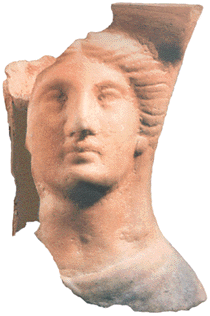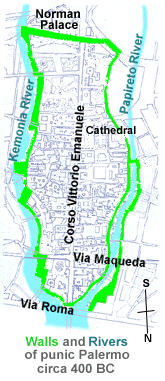...Best of Sicily presents... Best of Sicily Magazine. ... Dedicated to Sicilian art, culture, history, people, places and all things Sicilian. |
by Vincenzo Salerno | |||
Magazine Index Best of Sicily Arts & Culture Fashion Food & Wine History & Society About Us Travel Faqs Contact Map of Sicily
|
By circa 1500 BC, the Phoenicians had developed an alphabet of twenty-two characters. Written, like Hebrew, from right to left, it is the basis for all Western alphabets. Both the Roman and Greek alphabets are rooted in the Phoenician one, and the languages of Sicily's most ancient peoples, the Sicels and Sicans, when written, were inscribed using an alphabet based on Phoenician. Spoken Phoenician was a tongue quite similar to Hebrew and Moabite. Ethnic and political relations between the Phoenicians and Greeks were complex. Before the Phoenicians' arrival, northwestern Sicily was populated by a people called the Elimians (or Elami), who were soon amalgamated with the Siceliots (Sicilian Greeks). The Greeks' deities were similar to Phoenician ones, and vice versa. Their societies were remarkably similar, though the Greeks had the more advanced form of philosophy and government. Despite their contributions to Mediterranean culture, the Phoenicians seem a forgotten civilization whose culture was subsumed by those of the Hebrews, Greeks and Romans. Zis, the future Palermo, was founded around 800 BC. Initially, it was
little more than a trading colony of less importance than Motia (Mozia)
and Solus, the ancient hilltop city now known as Solunto. The most ancient
port of Palermo was located inland from its present location (the Cala near
Piazza Marina), closer to the area now called the Quattro Canti, and an
estuary reached as far as the mouth of the Kemonia River near the Church
of Saint Nicholas in what is now Piazza Ballarò, in the Albergheria
district. Piazza Marina and most of Corso Vittorio Emanuele between Via Roma and Porta Felice (near the coast) were under water. The area of ancient Zis corresponded, more or less, to the district called the "Cassaro" (from the Arabic al Kasr referring to the castle built on the site where the Norman palace was later constructed). Vestiges of the oldest Zis city walls are still visible in some places, such as Piazza Conte Federico. The so-called "Carthaginian
Cemetery" on Corso Calatafimi is actually Phoenician. Fragments of
a few Phoenician walls are located The Phoenicians' most important colony in the region was the North African city of Carthage. Amalgamated with local cultures, Carthaginian society continued to develop long after Phoenicia ceased to be an important force in the Mediterranean. The society of the Carthaginians represented the residual Phoenician culture in present-day Tunisia. Punic, the Carthaginian language, was a later Phoenician dialect influenced by African languages. By the fifth century BC, Zis had become, thanks to re-colonization, a Carthaginian city, but Sicily's Greeks made frequent forays into it. They called it Panormos (all port) and conquered it following a series of battles with the Carthaginians, who eventually returned. This paralleled the history of Himera (near Termini Imerese), where the Carthaginians were defeated by forces from Agrigento and Syracuse in 480, only to return in force in 408 BC, supported by Segesta. Panormos was their base of operations for these campaigns. In 254 BC, during the First Punic War, the Romans attacked Panormos, defeating a Carthaginian army. The persistent Carthaginians returned to be finally defeated in 251 BC. The annals of history mention Roman troops launching flaming arrows from the city walls overlooking the banks of the Kemonia River. The Papireto and Kemonia rivers no longer exist, the coastline now being located some distance northward, near the city's medieval Arab "Kalsa" district. Subsequent Punic Wars followed in mainland Italy, with Carthaginian incursions into other parts of Europe, but Carthage itself was finally destroyed by Rome and the former Carthaginian homeland became the Roman colony called "Africa." So ended the exploits of the likes of Hannibal and Hamilcar. Like their ancestors the Phoenicians, the Carthaginians were eventually amalgamated into the mainstream of Mediterranean culture as just one of the races from which Sicilians descend. History's negative portrayal of the Carthaginians owes as much to Greek and Roman propaganda as to historical fact. It is a reality that will persist so long as history is written by the victors, but something transcended by Palermo's Punic past. About the Author: Palermo native Vincenzo Salerno has written biographies of several famous Sicilians, including Frederick II and Giuseppe di Lampedusa. | ||
Top of Page |
 To the Phoenicians who founded what would become Sicily's largest
city, Palermo was Zis or Sis. But who were the Phoenicians?
Historians tell us they were a Semitic people, possibly from the Persian
Gulf originally, who around 3000 BC (BCE) established several settlements
in what is now Lebanon, Syria and Israel. Their most important cities were
Gebal, Sidon, Tsor and Berot (modern Beirut). This loose confederation,
Phoenicia, lived under constant threat from the Egyptians and Assyrians,
among others. As sea traders, the Phoenicians settled many Mediterranean
islands and coasts as far away as Spain (there is a theory that they sailed
the Atlantic to America), and it is in this enterprise that they founded
several Sicilian cities, including Zis.
To the Phoenicians who founded what would become Sicily's largest
city, Palermo was Zis or Sis. But who were the Phoenicians?
Historians tell us they were a Semitic people, possibly from the Persian
Gulf originally, who around 3000 BC (BCE) established several settlements
in what is now Lebanon, Syria and Israel. Their most important cities were
Gebal, Sidon, Tsor and Berot (modern Beirut). This loose confederation,
Phoenicia, lived under constant threat from the Egyptians and Assyrians,
among others. As sea traders, the Phoenicians settled many Mediterranean
islands and coasts as far away as Spain (there is a theory that they sailed
the Atlantic to America), and it is in this enterprise that they founded
several Sicilian cities, including Zis. beneath part of the Norman Palace, which may have been the site
of the fortified citadel of Zis. These are visible under the Duke Montalto
hall off the structure's main courtyard. And there's the deep walled pit
in Piazza Edison off Via Libertà (near Viale Lazio), once used for
grain storage. Mount Pellegrino is probably the Eircte where Hamilcar established his camp during the First Punic War, and traces of a fortified site dated to that era have been found there. Punic inscriptions have been found in the Regina Cave on Mount Gallo overlooking Mondello. Hundreds of Phoenician and Carthaginian grave sites have been found in necropoli in a large inland area south of the Norman palace, where the Norman kings had a vast park. Today these areas are covered by buildings along Corso Calatafimi. Truth be told, there's more evidence of Phoenician culture to be readily seen at Erice, Marsala, Mozia and Solunto, though Palermo's
archeology museum offers some good glimpses into the city's Punic past.
beneath part of the Norman Palace, which may have been the site
of the fortified citadel of Zis. These are visible under the Duke Montalto
hall off the structure's main courtyard. And there's the deep walled pit
in Piazza Edison off Via Libertà (near Viale Lazio), once used for
grain storage. Mount Pellegrino is probably the Eircte where Hamilcar established his camp during the First Punic War, and traces of a fortified site dated to that era have been found there. Punic inscriptions have been found in the Regina Cave on Mount Gallo overlooking Mondello. Hundreds of Phoenician and Carthaginian grave sites have been found in necropoli in a large inland area south of the Norman palace, where the Norman kings had a vast park. Today these areas are covered by buildings along Corso Calatafimi. Truth be told, there's more evidence of Phoenician culture to be readily seen at Erice, Marsala, Mozia and Solunto, though Palermo's
archeology museum offers some good glimpses into the city's Punic past.